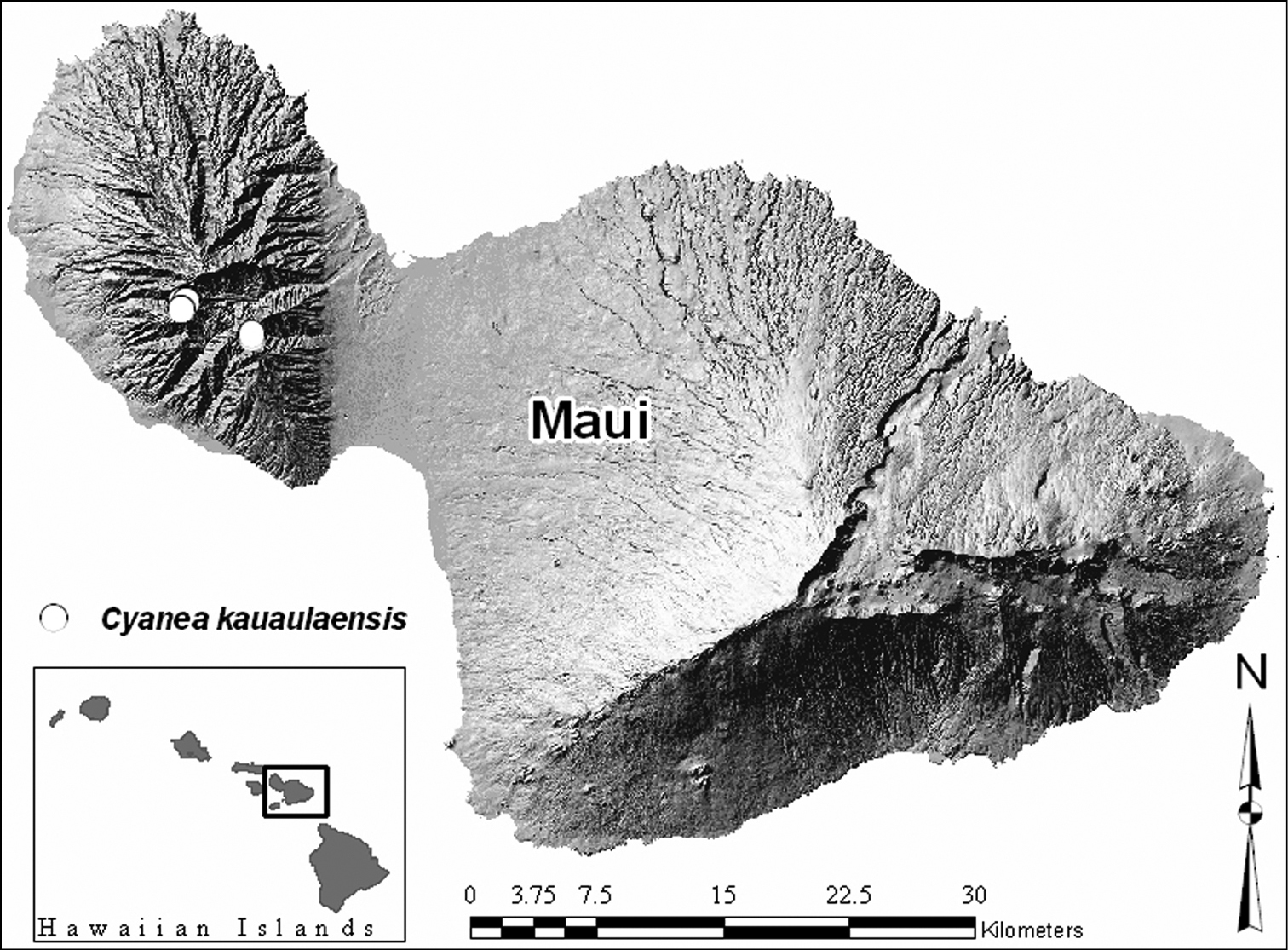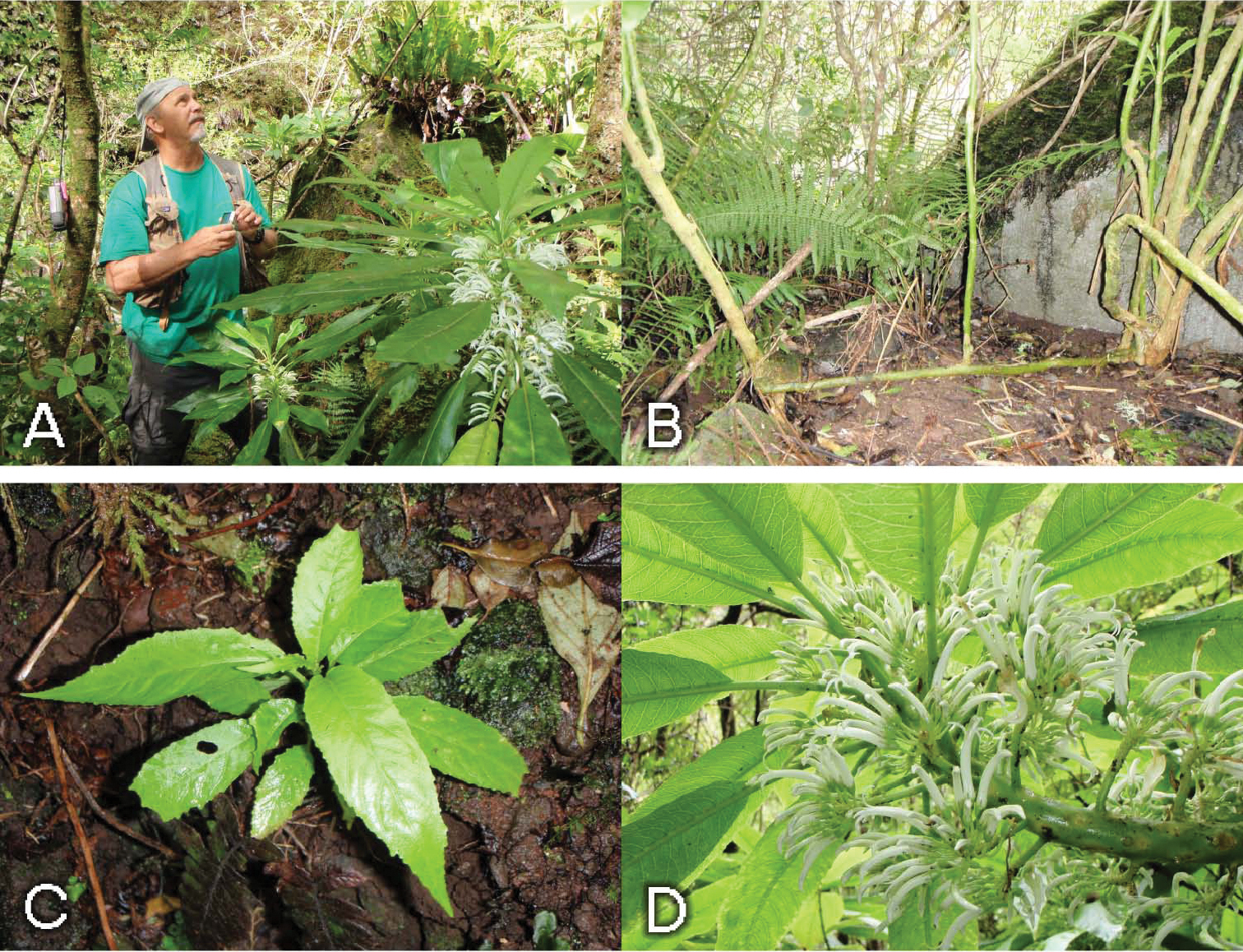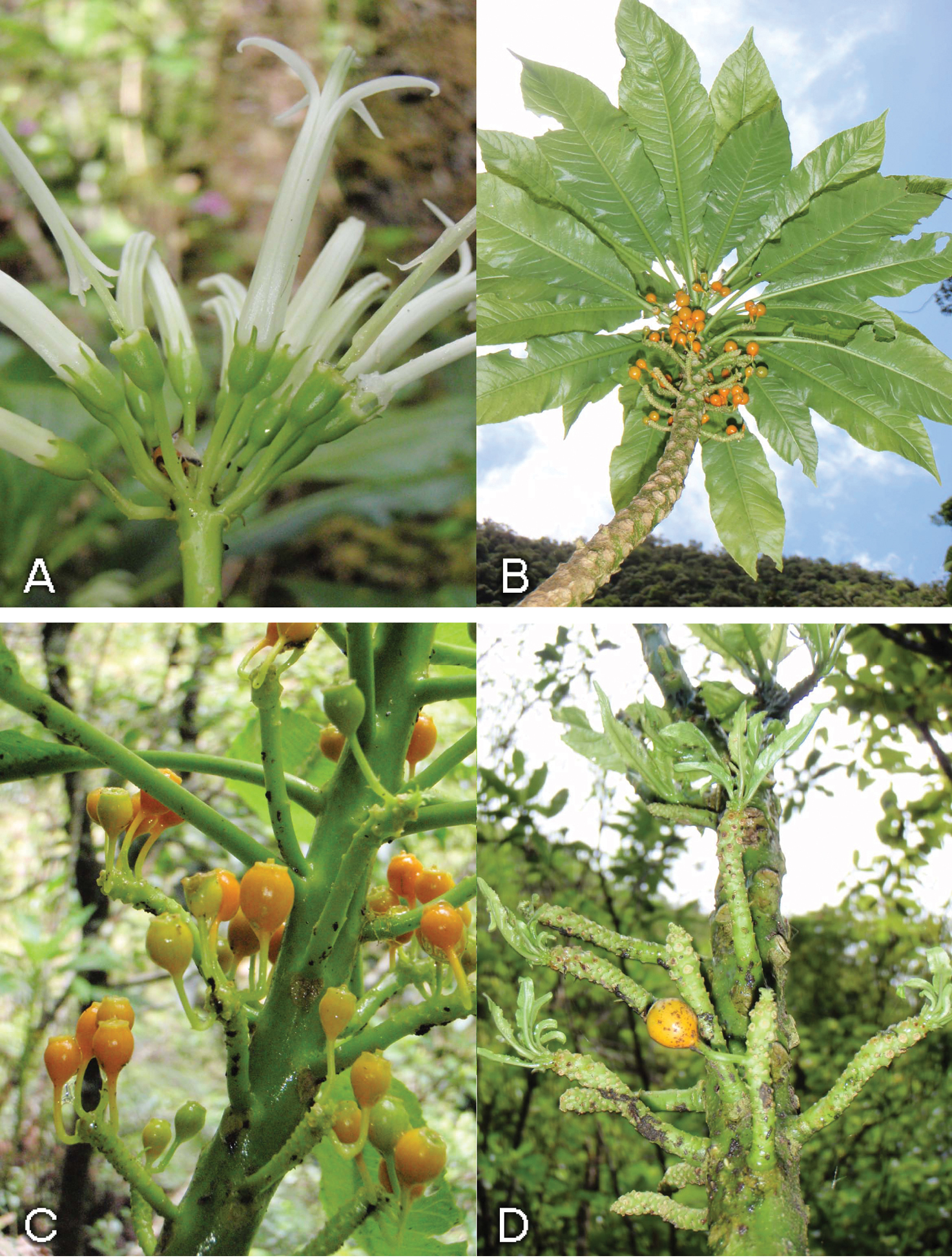






(C) 2012 Hank Oppenheimer. This is an open access article distributed under the terms of the Creative Commons Attribution License 3.0 (CC-BY), which permits unrestricted use, distribution, and reproduction in any medium, provided the original author and source are credited.
For reference, use of the paginated PDF or printed version of this article is recommended.
Cyanea kauaulaensis H. Oppenheimer & Lorence, sp. nov., a new, narrowly endemic species from Maui, Hawaiian Islands is described, illustrated with field photos, and its affinities and conservation status are discussed. It is currently known from 62 mature plants and is restricted to Kaua`ula and Waikapu valleys on leeward western Maui. It differs from all other species of Cyanea by its combination of many-branched habit; glabrous, unarmed, undivided leaves; small, narrow, glabrous corollas with small calyx lobes that do not persist in fruit; and bright orange, subglobose to obovoid fruits.
Campanulaceae, conservation, Cyanea, Hawaiian Islands, IUCN Red List, Maui
As currently circumscribed, the woody lobelioid genus Cyanea Gaudich. (including Rollandia Gaudich.) comprises 78 species (
Distribution map of Cyanea kauaulaensis showing known localities on East Maui.
Critical study of these collections reveals that they are not Cyanea glabra nor even closely related to it, and clearly represent an undescribed species. Based on the description in
urn:lsid:ipni.org:names:77120339-1
http://species-id.net/wiki/Cyanea_kauaulaensis
Figures 2 , 3Species allied to Cyanea profuga C. Forbes, differs in its narrower leaves 5–7 cm wide, inflorescences with more numerous flowers (up to 20); flowers with smaller, lanceolate to linear calyx lobes 2–3 × 0.5–0.7mm, apex acute to acuminate, shorter than the hypanthium, comparatively shorter corolla lobes 1/3-2/5 as long as the tube, and subglobose to obovoid orange fruits.
USA. HAWAIIAN ISLANDS: West Maui: Lahaina District, N fork of Kaua`ula Valley, 910m (3000 ft), 2 Dec 2008, H. Oppenheimer & S. Perlman H120806(Holotype PTBG-058138 [+ spirit collection]!; Isotypes BISH!, US!).
Unarmed shrubs 2–4 m high, many-branched from the base with many basal shoots, stems light brown, erect to arching, up to 6m long, sometimes leaning on adjacent vegetation, often rooting where in contact with soil, leaf scars subcircular to broadly obovate-depressed; latex white. Leaves clustered near the end of the branches, when fresh light green on both surfaces, fleshy, the adaxial surface moderately glossy, drying membranaceous to chartaceous, glabrous on both surfaces, in juvenile plants occasionally minutely muricate adaxially along costa, elliptic, oblong, or elliptic-oblong, in adult plants blade 19–30 × 5–7 cm, base attenuate to cuneate, often asymmetrical, apex attenuate, acuminate, or cuspidate, margins entire to minutely serrulate-dentate, often undulate when fresh, sometimes coarsely serrate-dentate in juvenile plants; petioles 5–10 cm long, glabrous. Inflorescences axillary and on leafless nodes, developing along stems after leaves have fallen on well developed individuals, up to 30 per stem, mostly perpendicular to the stem, 5–20 flowered, peduncles 15–70 mm long, glabrous. Flowers on pedicels (4) 8–12 mm long, filiform, glabrous, subtended by caducous linear-subulate to linear bracts 12–20 × 3 mm, margins minutely serrulate, glabrous, pedicels with 2–3 glabrous subulate-oblong bracteoles 0.3–0.6 mm long; hypanthium 4–5 × 2.5–4 mm, broadly ellipsoid to obovoid-obconic; calyx lobes 2–3 × 0.5–0.7 mm, lanceolate to linear, apex acute to acuminate, caducous in fruit; corolla white, tubular, round in cross section, gently curved to suberect, 28–35 × 3–4 mm, externally glabrous, internally minutely papillose, the tube 23–27 mm long, the lobes 5–10 mm × 0.5–0.9 mm medially, linear-subulate, reflexed, initially 1/3 to 2/5 as long as the tube but eventually splitting more deeply; staminal column glabrous, anthers 6–7 mm long, glabrous, the lower 2 with apical tufts of white hairs 3–4 mm long. Fruits bright orange when ripe, 8–10 mm in diameter, globose to obovoid, smooth, apex crowned by an apicular ring, calyx lobes caducous very early when fruits still small and green; old infructescences often producing leaves and continuing to develop as lateral shoots. Seeds numerous, embedded in translucent pulp, ovoid-ellipsoid, 0.5–0.6 × 0.35–0.4 mm, testa brown, shiny, smooth with faint striations.
Known only from West Maui, Hawaiian Islands.
Cyanea kauaulaensis occurs in riparian sites, on talus or basalt boulder-strewn slopes along perennial streams at elevations of 732 to 914 m. The plant community represents a Metrosideros Banks ex Gaertn. lowland wet forest. The most common associated woody elements are species of Antidesma L., Boehmeria Jacq., Broussaisia Gaud., Cheirodendron Nutt. ex Seem., Clermontia Gaud., Coprosma J.R. Forst. & G. Forst., Cyrtandra J.R. Forst. & G. Forst., Dodonaea Mill., Dubautia Gaud., Ilex L., Kadua Cham. & Schltdl., Perrottetia Kunth, Pipturus Wedd., Psychotria L., Urera Gaud., and Xylosma G. Forst. Ferns including species of Asplenium L., Cibotium Kaulf., Cyclosorus Link, Deparia Hook. & Grev., Diplazium Sw., Dryopteris Adans., Elaphoglossum Schott ex J. Sm., Microlepia C. Presl, Pteris L., Sadleria Kaulf., Tectaria Cav., and Vandenboschia Copel. are prevalent. Freycinetia arborea Gaud. is a widespread liana, and several herbaceous species of Peperomia Ruiz & Pav. are also present. The sedge genera Machaerina Vahl. and Rhynchospora Vahl are also frequent. Soil is of typical basaltic origin. The average annual rainfall is approximately 3000 mm. Due to the steep canyon walls, often 700 m tall, direct sunlight is restricted to midday, and varies seasonally. Plants occur on both sides of the streams, with no apparent preference. Adult plants are clumped (Fig. 2A) and often many branched from the base, the decumbent branches often rooting when in contact with the ground and forming “runners”, often with erect shoots (Fig. 2B). Stems are erect to ascending or vine-like, to 6m long, often leaning on and tangled with adjacent vegetation, growing on lower talus slopes in riparian areas along perennial streams. On some stems old infructescences were observed to produce leaves and continue to grow as lateral shoots (Fig. 3D). This may represent a mechanism for producing lateral branches.
Cyanea kauaulaensis. A habit, with Steve Perlman (Oppenheimer & Perlman H120806) B base of plants showing new stems arising from decumbent branch (Oppenheimer & Perlman H120806) C juvenile plant (Oppenheimer & Wood H20928) D flowering stem (Oppenheimer & Perlman H120806); photos by H. Oppenheimer.
Cyanea kauaulaensis. A inflorescence (Oppenheimer & Perlman H120806) B fruiting stem (Oppenheimer et al. H40919) C infructescences (Oppenheimer et al. H40919) D old infructescences becoming lateral shoots (Oppenheimer & Wood H20928); photos by H. Oppenheimer.
Cyanea kauaulaensis has been observed flowering from late summer through January, followed by fruits maturing in March and April. Sporadically, some individuals may possess a few flowers or fruits earlier in summer.
The specific name honors Kaua`ula Valley, a large, amphitheatre-headed valley on leeward Mauna Kahalawai (aka West Maui). Lit., the red rain (
Cyanea kauaulaensis should be considered Critically Endangered due to its limited range, low population numbers, lack of population structure and poor seedling recruitment, probable loss of most or all of its avian pollinators and dispersal agents, landslides, flooding, herbivory by alien slugs and rats, and competition with alien plants such as Ageratina adenophora (Sprengel) R.M. King & H. Rob., Buddleia asiatica Lour., Coffea arabica L., Cortaderia jubata (Lemoine ex Carrière) Stapf, Erigeron karvinskianus DC, Macaranga tanarius (L.) Müll. Arg., Melinis minutiflora P. Beauv., Rubus rosifolius Smith, Setaria palmifolia (J. König) Stapf. and Toona ciliata M. Roem. Approximately 45 plants plus four seedlings were observed during the recent visits in Kaua`ula Valleys north fork, three in the south fork, and 12 in Waikapu Valley. Recently, a new species of the endemic Hawaiian genus Stenogyne Bentham (Lamiaceae) was described from elsewhere in Kaua`ula Valley (
When evaluated using the IUCN Red List criteria Cyanea kauaulaensis falls into the Critically Endangered (CR) category, a designation reserved for species facing the greatest risk of extinction in the wild, as it fulfills the following criteria: B) Extent of occurrence estimated to be less than 100 km² or area of occupancy estimated to be less than 10 km²; 2c) Continuing decline observed in area, extent and/or quality of habitat; 2c(iv) Continuing decline observed in number of mature individuals; C) Population size estimated to number fewer than 250 mature individuals and C2a(1) no subpopulation estimated to contain more than 50 mature individuals. This species has a known range of less than 100 km², and an area of occupancy of less than 10 km² currently known from three populations, two in Kaua`ula Valley and one in Waikapu Valley, both on West Maui. Furthermore, Cyanea kauaulaensis should be considered by the US Fish & Wildlife Service as a Candidate for listing as Endangered under the Endangered Species Act of 1973, and a Recovery Plan written, funded, and implemented.
The Maui Invasive Species Committee (MISC) has been working to control the Cortaderia infestation in both valleys on the surrounding, vertical cliffs. The region has escaped the ravages of introduced feral ungulates due to the extremely rugged topography. This new species is a target of the Plant Extinction Prevention Program (PEPP), with efforts made to collect seeds from every individual plant, propagation of nursery stock, restoration outplanting into appropriate habitat, and ex situ seed storage. In April of 2009 seeds from 32 of the 45 plants in the north fork subpopulation were collected. The south fork subpopulation was sampled in 2004 and the population seemed stable with twelve plants. It was revisited in October 2010. Only three individuals remained, and the habitat had been significantly degraded by dense stands of Coffea arabica. Plants have been successfully grown at Lyon Arboretum, Honolulu, the National Tropical Botanical Garden, Kaua`i, and the Olinda Rare Plant Facility on Maui. In October 2010 84 plants from seeds collected in the north fork were planted in the south fork, in the hopes of augmenting the diminishing population there. In September of 2011, 16 plants from the north fork of Kaua`ula Valley were planted adjacent to the Waikapu population.
USA. Hawaiian Islands. Maui [West Maui]: Lahaina District, AMFAC survey by TNCH, Kauaula Valley, back of valley near streambed, 27 Oct 1989, Perlman & Gon 10841 (F, BISH, PTBG, US); back of Kauaula Valley on west side, 866 m, 2 Dec 2008, Perlman & Oppenheimer 21284 (PTBG, BISH, NY, US), east side fork, 18 Jan. 1995, Perlman et al. 14626 (F, MO, NY, PTBG), 2700 ft. (823m), Perlman et al. 18875 (OSH, PTBG); Kaua`ula Valley, N fork, 3000 ft (914m), 6 Apr 2009 (fr), Oppenheimer et al. H40919 (BISH, PTBG [+ spirit coll.]), Kaua`ula Valley, N fork, 3000 ft (914m), 18 Feb 2009, Oppenheimer & Wood H20928 (PTBG), 2950 ft (899m), 1 July 2009, Oppenheimer & Perlman H70901 (PTBG); North fork headwaters, 2780 ft (847m), 26 Sep 2009, Oppenheimer & Kia 90914 (PTBG), Kauaula Valley, upper south fork below Helu, 2700 ft (823m), 18 Jan 1995, Wood et al. 3940 (PTBG); Wailuku District, Waikapu Valley, north fork, 2400 ft (732m), Jul 2011, Oppenheimer & Bustamente H71103 (BISH, PTBG).
Several attempts have been made to divide Cyanea into sections (
The following couplets can be inserted into the most recent revision of Cyanea (Lammers in Wagner et al. 1990) to separate Cyanea kauaulaensis from Cyanea profuga.
| 15(13) | Leaf margins irregularly lobed or cleft; Mo | 11 Cyanea dunbariae |
| 15 | Leaf margins callose-toothed, erose, entire or minutely serrulate | (15’) |
| 15’(15) | Leaf margins entire or minutely serrulate; calyx lobes lanceolate to linear, apex acute to acuminate; M | Cyanea kauaulaensis |
| 15’ | Leaf margins callose-toothed or erose | (16) |
| 16(15’) | Calyx lobes oblong, apex rounded and apiculate; Mo | 38 Cyanea profuga |
| 16 | Calyx lobes dentiform or triangular, apex acute to acuminate | (17) |
The authors extend our deepest gratitude to Makila Land Co. and Wailuku Water Co. for permission to access Kaua`ula Valley and Waikapu Valley respectively; The West Maui Mountains Watershed Partnership for assistance in the field; Windward Aviation, Inc. for their skilled helicopter pilots; horticulturists Anna Palomino at the Olinda Rare Plant Facility, Bob Nishek at the National Tropical Botanical Garden (NTBG), and Nellie Sugii at the Lyon Arboretum; Alvin Yoshinaga and Tim Kroessig at the Lyon Arboretum Seed Storage Laboratory; botanists Steve Perlman and Ken Wood of NTBG for their assistance in the field as well as many helpful discussions; the Maui Invasive Species Committee for field assistance and Cortaderia grass control efforts. Clyde Imada at BISH was extremely helpful finding both Wimmers publication as well as C. N. Forbes’ field notes, helping to clearly establish Cyanea kauaulaensis as distinct from Cyanea glabra. Michael Kiehn (Vienna University) assisted with providing information on the isotypes of Cyanea glabra at WU. This manuscript was greatly improved by suggestions from Tom Lammers at University of Wisconsin at Oshkosh and anonymous reviewers. The Plant Extinction Prevention Program is funded in part by the U.S. Fish & Wildlife Service, and the State of Hawaii Dept. of Land & Natural Resources, Division of Forestry and Wildlife. We thank the curators of the Bernice P. Bishop Museum herbarium (BISH) and National Tropical Botanical Garden herbarium (PTBG) for access to specimens. The color plates were composed by Neil Brosnahan.


